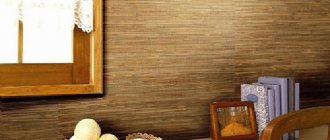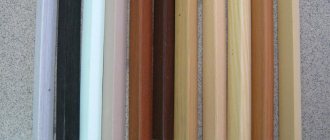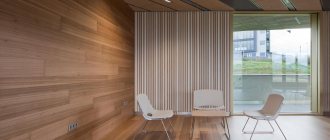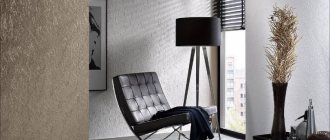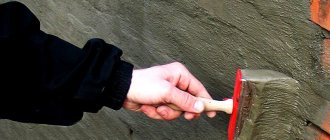The presence of a cellar in a private house, country house or country house means that this structure requires care.
Not only does it need to be ventilated, cleaned, removed unnecessary or missing products, and sorted what is stored on shelves and in different areas. In addition, the cellar requires cosmetic care. In particular, it is important what kind of paint your “underground warehouse” will be painted inside; the atmosphere inside the room depends on this.
Painting a cellar is not a complicated process at all. It will, of course, require attentiveness, accuracy and patience from you. In order to paint the cellar successfully, you will need the following materials and tools:
- coloring composition;
- roller;
- work clothes;
- paint container;
- protective breathing mask;
- gloves, the stronger the better.
The painting process itself will not take much time. However, the most important thing in this process will be the choice of paint. It is necessary to paint the cellar with a composition suitable for the material with which the walls are lined or from which the floor is made.
Moisture-resistant base is a prerequisite for long service life
The cellar must be painted with moisture-resistant paint; it will not come off due to high humidity.
So, if the walls or floor in the room are concrete, then painting with ordinary enamel paint will not work, it will not hold up and will come off in the near future, since moisture will form in the cellar, and ordinary paint will not be able to withstand it. For wet concrete, a substance with a waterproof structure is suitable. This can be a varied water-based structure of the main color, for which you can choose the desired color.
To do this, simply select the desired color scheme. The color of the cellar is not the main factor. The main thing is that the paint lasts for at least a year. There are known cases when concrete was painted with enamel paint; within a week the paint was covered with moisture, after which its structure was destroyed. For wet concrete, it is best to choose water-based paint. Or paint that contains special toxic substances. This group of paints is called silicate. This paint will last at least 5 years and will withstand moisture even in large quantities. Water will simply roll off it.
How to whitewash walls and ceilings correctly
Whitewashing is a traditional way to get rid of high humidity from walls, destroy mold and fungal spores. Slaked lime is a good antiseptic and fire retardant, it is inexpensive and easy to use.
Chalk is used for whitewashing - it creates a decorative coating without antiseptic properties. It is more often used for finishing above-ground premises.
Lime copes better with disinfection in the cellar than chalk, so it is worth whitewashing the walls and ceiling with a lime composition. The solution is applied to the surface with a paintbrush in 1-2 steps and allowed to dry. The coating is quite durable and does not wash off easily with water. You can add blue or pigment for decoration.
Using lime whitewash
If the walls inside the cellar are wooden, you can use whitewash. Painting the cellar with chalk is a good solution in cases where the humidity is not very high and the ventilation is properly equipped and working.
Whitewashing a cellar is good if the humidity in it is low.
Lime is suitable for almost any type of wall decoration. Painting the cellar with lime is the most reliable option, since in addition to the appearance and transformation of the cellar, you also get an anti-fungal coating. Lime has long been known as a substance that can kill pathogens and microorganisms. By choosing a lime whitewash method, you solve two problems at the same time. In addition, lime mortars are quite affordable for every consumer.
In addition, modern manufacturers offer a range of paints for wet rooms with an antifungal effect, developed by scientists. These paints have unique functions. They release moisture from the concrete, but do not let it in. It turns out that your walls will “breathe”. This is a great option, but you will have to pay a little more money for such paint.
Another expensive option for painting a cellar is liquid glass paint. Most often used for industrial purposes, in warehouses and bunkers. Expensive, but quite long-lasting option. Having painted your cellar with this paint, you don’t have to worry about updating it for 15 years. Paints on liquid glass are not afraid of strong moisture or changes in humidity, so this is an excellent choice for painting the interior walls of a cellar.
Expensive compounds
An improved type of antibacterial paint will cost more.
We have long ago developed a new unique composition for painting rooms with a lot of moisture:
- This mixture selects moisture from the concrete, but, on the contrary, does not let it in. The walls have the ability to “breathe”, and for the basement this is the best option.
- Operational period up to 15 years. It is usually used in warehouses and bunkers.
- This composition is not afraid of either humidity (consistently high) or its changes, so it is ideal for the basement.
The only disadvantage of this coverage is the price is quite high. But the result will be high-quality and long-term.
Acrylic paints
Using acrylic paints in the basement
Very expensive, but effective. The most universal option, ideal for all types of surfaces, for any kind of materials.
- Environmentally friendly, absolutely harmless. This is especially true for a cellar, if we remember its direct purpose - storing food products.
- Another advantage of acrylic paints is their wide range of colors. There is an opportunity to give the basement space individuality.
- It is believed that a discreet dark shade is more consistent with the atmosphere of the room and looks more appropriate.
Note. When drying, acrylic paint becomes darker by 2-3 tones. You can always revive and diversify your cellar with the help of furniture, shelves, and various accessories.
Acrylic adheres well to the surface, even when diluted; does not spread due to its elasticity. The coating does not crack and does not lose its shine over time. The acrylic composition goes well with other paints, so you can easily decorate the walls of the cellar with patterns, for example.
Acrylic paint - expensive but effective
Acrylic paint is durable, but expensive.
Acrylic paints are suitable for any surface or any kind of material. This is one of the most expensive ways to protect and improve your cellar. Acrylic options have a large selection of colors. So you can paint the walls in any color that suits your imagination. It is still recommended to paint the cellar in dark colors, since the atmosphere should be appropriate. But you can choose shelves, furniture and some storage accessories in bright colors or paint them in bright tones.
If this is not your first time painting walls or floors, you should remove the layer of old coating. You need to clean it and, if necessary, brush it to remove residues and small pieces.
One of the most important rules to follow is the principle of safety. When choosing paint or whitewash, focus on the interaction of paint with food products. Of course, if your cellar involves storing any products. It is important that the paint does not release toxins, otherwise all the products in the cellar will be dangerous.
In the painting process itself, do not forget about your own safety. Inhaling the fumes released by paints and whitewashes is extremely dangerous. Painting the cellar will be safe if you use a protective mask or respirator. As a rule, a day is enough for paint or whitewash to dry. For complete drying, you should wait 2-3 days. After which it is important to carry out good ventilation, and then use the cellar, lay out food there and other things that are intended for storage.
As for painting the floor, if it is wooden, ordinary oil paint will do. It will withstand anything and will last a long time. If the floors are concrete, then it is best to use the same paint as for the walls. And in most cellars the floors are left earthen, so painting is not required.
Poor-quality cellar finishing can ruin even a spacious underground room and turn it into a cold and damp place with an unpleasant odor. Vegetables in such cellars are poorly stored due to high humidity; in winter, the crop can freeze and in spring suffer from groundwater rising on the floor. However, this situation can be corrected if the issue of finishing the cellar inside is approached with due attention. To do this, you need to be patient and have some free time. If you wish, you can even make a special design for the room.
Preparatory work
Like the rest of the house, the cellar requires care and attention from the owners. The first thing you need to take care of is protecting the room from moisture. To do this you will have to resort to waterproofing. This way you will get rid of excess water inside the cellar and forget about mold forever.
A quick guide to waterproofing:
- Before starting construction work, carefully inspect the room for leaks and other problem areas. After they are “neutralized”, proceed to the first stage of work.
- The first stage is the external drainage of the underground floor. If your soil is predominantly swampy, then perform internal drainage of the cellar. This will prevent moisture from penetrating inside.
- At the second stage, arrange a waterproof blind area. To do this, concrete a circular plot of land that “encircles” the house. Now your cellar is not afraid of rain and melt water.
- The next stage is the use of adhesive or penetrating waterproofing. It is best to combine these methods of protection against water with each other.
At the final stage, finishing is carried out (which we will talk about later) or, if necessary, insulation.
When finishing the cellar, use moisture-resistant materials. This will provide additional protection and a comfortable indoor microclimate.
Reviews and comments
Important! Proper waterproofing of the basement or basement plays a significant role in the reliability and durability of the entire building.
Modern stylish house with attic and basement
Modern house designs with an attic and a ground floor are in great demand. Therefore, it is worth considering them in more detail. Here is a stylish building with a total area of 220.0 m2. Quite small dimensions - 11.7 x 11.1 m, allow this cottage to be used as a country house or for permanent residence. An interesting feature is the presence of a winter garden. => We select projects of houses with a basement and an attic - what are their features and layout options [post_excerpt] => [post_status] => publish [comment_status] => open [ping_status] => closed [post_password] => [post_name] = > proekt-doma-na-sklone-s-cokolnym-etazhom-351 [to_ping] => [pinged] => [post_modified] => 2018-08-14 13:23:00 [post_modified_gmt] => 2018-08- 14 09:23:00 [post_content_filtered] => [post_parent] => 0 [guid] => https://pogreb-podval.ru/?p=8771 [menu_order] => 0 [post_type] => post [post_mime_type ] => [comment_count] => 0 [filter] => raw [robotsmeta] => ) ) [post_count] => 1 [current_post] => -1 [in_the_loop] => [post] => WP_Post Object ( [ID ] => 8771 [post_author] => 2 [post_date] => 2018-08-14 12:03:46 [post_date_gmt] => 2018-08-14 08:03:46 [post_content] => => Selecting house designs with a ground floor and an attic - what are their features and layout options [post_excerpt] => [post_status] => publish [comment_status] => open [ping_status] => closed [post_password] => [post_name] => proekt-doma- na-sklone-s-cokolnym-etazhom-351 [to_ping] => [pinged] => [post_modified] => 2018-08-14 13:23:00 [post_modified_gmt] => 2018-08-14 09:23: 00 [post_content_filtered] => [post_parent] => 0 [guid] => https://pogreb-podval.ru/?p=8771 [menu_order] => 0 [post_type] => post [post_mime_type] => [comment_count ] => 0 [filter] => raw [robotsmeta] => ) [comment_count] => 0 [current_comment] => -1 [found_posts] => 385 [max_num_pages] => 385 [max_num_comment_pages] => 0 [is_single] => [is_preview] => [is_page] => [is_archive] => [is_date] => [is_year] => [is_month] => [is_day] => [is_time] => [is_author] => [is_category] => [is_tag] => [is_tax] => [is_search] => [is_feed] => [is_comment_feed] => [is_trackback] => [is_home] => 1 [is_404] => [is_embed] => [is_paged ] => [is_admin] => [is_attachment] => [is_singular] => [is_robots] => [is_posts_page] => [is_post_type_archive] => [query_vars_hash:WP_Query:private] => 6129f5cdc20b4c1e94260eff05cd3b0b [query_vars_changed:WP_Query :private] => [thumbnails_cached] => [stopwords:WP_Query:private] => [compat_fields:WP_Query:private] => Array ( [0] => query_vars_hash [1] => query_vars_changed ) [compat_methods:WP_Query:private] => Array ( [0] => init_query_flags [1] => parse_tax_query ) )
We take care of thermal insulation
Having ensured high-quality waterproofing of the cellar, we move on to thermal insulation. What is it for? Thermal insulation allows you to maintain the desired temperature in the cellar, regardless of the weather conditions outside. This is important when storing and preserving vegetables, since high temperatures will promote crop germination, and too low temperatures will promote freezing.
To insulate the floor, you can use expanded clay or foam chips.
So, a plastic film is laid on the floor, and wooden or metal logs are installed. Thermal insulation material is tightly placed into the resulting cells.
Insulation of the cellar floor using expanded clay.
When laying thermal insulation material, it is unacceptable to leave voids. The entire space should be evenly filled with material. Then the surface is leveled and filled with concrete mixture. To increase the reliability of the floor, additional reinforcement is carried out. To do this, use a metal or fiberglass mesh.
After the concrete mixture has hardened, we begin finishing the floor. For this you can use various coatings and materials. It is not only the insulation of the floor that needs to be taken care of. The walls of the room also require attention.
For walls, heat insulators in the form of slabs or mineral wool are used. Installing insulating material is easy. The same insulation technology is applied to any material. The slabs are laid on the prepared walls and secured with special fasteners.
Don't forget, insulation is important (especially for food cellars).
Processing the outside of the cellar walls
The walls of the cellar are quite a massive structure. The height of wall panels is usually about 2 meters. This will be enough to place 3 shelves vertically for supplies. The thickness of the concrete walls is 5 cm, the brick wall is 12-25 cm (depending on the masonry), and the rubble stone wall is 25 cm. As already mentioned, the mass of the panels is large, so during construction the walls should be mounted on solid ground so that they do not move. When preparing a hole for a cellar, you need to dig until there is strong, stable soil (if this is possible under ground conditions). The outer side of the cellar walls is constructed in the following sequence:
- First, to maintain a constant temperature in the cellar, thermal insulation is laid on the outside of the walls, for example, with inexpensive polystyrene foam boards. The material is quite durable, moisture resistant, easy to cut and fasten. Please understand that this is a flammable material and also that it is attractive to rodents. The polystyrene foam must not only be glued to the walls with special glue, but also reinforced with dowels with a wide mushroom head.
- During the work, the biggest problem is creating tightness of the joints between the walls and the floor. In places where soil moisture is high, a concrete bath can be made during construction: the floor is poured and monolithic walls are installed on it. In this case, the joints are hermetically sealed. An expensive method, but effective.
- Usually, the second layer after the thermal insulation material is waterproofing: 2 layers of bitumen, on top of a layer of roofing material.
- You can even additionally make clay waterproofing for reliability.
- If thermal insulation material was not laid during construction, we recommend digging up the cellar walls again, waiting until they dry, laying thermal insulation, waterproofing and covering the walls with earth again.
Start of finishing the cellar
The cellar should not only be regularly ventilated, but it also needs periodic cleaning and tidying. Cleaning involves getting rid of unnecessary or missing products, removing cobwebs, etc. In addition, the cellar, like any other room, requires cosmetic care.
Before starting finishing work, it is necessary to thoroughly clean all surfaces.
The decoration of a cellar differs significantly from the decoration of a living space. Materials that are great for rooms are not suitable for work in the cellar (and vice versa).
To finish the cellar, paint “for the underground room” is often used. It has the necessary properties, is moisture resistant and does not emit toxic substances. Painting the walls in the cellar is not a complicated, but painstaking process. You must have patience and accuracy, then the result will exceed your expectations.
Before work, prepare the necessary tools:
- Paint the desired color.
- Roller.
- A container where you will pour the paint.
- Clothes that you are not afraid to get dirty.
- Gloves.
- Respirator or protective mask.
Cellar paint is toxic
Many people think that painting a cellar is easy, because the design of this room does not require any special frills. Indeed, beautiful basements are not as important as exquisite decoration of living spaces.
But the process of painting a cellar does not become simple:
- Before starting work, you need to remember safety precautions. The consequences of a frivolous attitude towards them can be catastrophic.
- The main danger lies in ventilation, or more precisely in its absence or improper functioning.
- It is impossible to carry out work in a stuffy room without a flow of fresh air.
Advice. When painting, you need to wear a protective mask, a respirator, and best of all, a gas mask. In a respirator, you will have to breathe the same poisoned air, only slightly restrained by thick fabric. But using a hose gas mask will allow you to breathe fresh air from the street while being in the basement.
Paint or lime?
The choice of paint depends on the wall and floor covering. If you used concrete, apply a moisture-resistant base before painting. Without it, the paint will not last long, as moisture will cause it to peel off. In addition, there are materials with a water-resistant structure, for example, various emulsions. They have a wide range of colors and are quite durable. After applying the emulsion, you can choose the paint of the required color, depending on the design of the cellar, and treat the walls again.
Painting concrete with water-based paint.
When choosing paint, pay attention to its expiration date. Regular paint will last no more than one year. Due to the special microclimate in the cellar, enamel paint can “slide” off concrete surfaces after a couple of weeks. This is due to increased humidity in the room. Paints with a service life of more than five years are suitable for wet concrete; such paints belong to the group of silicate paints. They do not emit toxic substances and do not absorb moisture (water simply drains from them).
Whitewashing the ceiling with slaked lime.
Slaked lime is often used to finish the cellar. It is suitable for whitewashing in rooms with low humidity and good ventilation. Lime has antifungal properties, so if you're concerned about mold, it's a great solution for giving your cellar a makeover. Lime has long been known as an excellent means of combating pathogens. Another advantage of lime whitewash is its low cost. The same cannot be said about expensive paints, which are capable of releasing moisture from concrete, but do not allow it to penetrate into it. Such paints are made on the basis of liquid glass.
Paints based on liquid glass are mainly used in industrial enterprises and have a long service life. This coating is not afraid of strong moisture and temperature changes, so if you can afford such paint, you will forget about finishing the cellar for more than 15 years.
Also, an excellent competitor to lime whitewash is acrylic paint. It can be used to treat any surface. This type of finishing is also not cheap. However, the effectiveness of this method justifies the expense. With this paint you can update the design of the cellar and give it a more noble look. A wide range of colors will allow you to turn the most unusual ideas into reality.
Designing a basement in a garage
At the first stage of laying the foundation of a garage with a cellar, it is necessary to find out three facts:
- at what level the groundwater is located at the construction site;
- determine the depth of soil freezing;
- the design, depth and waterproofing of the foundation depend on the type of soil on the site.
If the garage has already been built and there is a desire to dig a cellar, then you need to pay attention to the following parameters:
- foundation design - a shallowly buried strip foundation will not withstand load-bearing loads, if you remove a large layer of soil inside the building - it is necessary to deepen and strengthen the foundation;
- if groundwater is located high, it is necessary to install a drainage system;
- on clayey and weak peat soils, it is important to pay attention to serious external waterproofing of the basement.
An important rule for the foundation of a garage with a cellar is that the lowest point of the foundation must be located at least 50 centimeters below the freezing point of the soil. During frost, the soil freezes and pushes out the weak foundation, which leads to rapid deformation and destruction of the entire building.
Construction of a basement in a finished garage
When digging a pit in an already built garage, especially if the cellar floor is much lower than the base of the garage foundation, it is important to correctly maintain the distance to the walls:
- to the garage wall, the basement wall is located at a distance equal to the depth of the basement below the base of the foundation.
For example, the cellar floor is 1 meter lower than the garage foundation. This means you need to step back a meter from the foundation when digging a pit.
Painting Tips
It is recommended to finish the underground space, taking into account the following points:
- When choosing a paint color for your cellar, opt for darker tones.
- If you are repainting, clean the walls and get rid of the old coating. To do this, go over the walls thoroughly with a metal brush.
- When choosing paint or other material for wall decoration, consider the safety of this material. It should not emit toxic substances.
- Before painting the basement, protect yourself with a respirator or a special mask. The work will be carried out in a room with poor ventilation, so without special protection there is a danger of poisoning from toxic fumes.
- After treating the walls with whitewash or paint, leave the room to ventilate for 72 hours. During this time, harmful fumes will disappear and the cellar will become suitable for use.
- If you have a wooden floor in your cellar, use oil-based paint to finish it. You will be pleased with its wear resistance and long service life. It is better to treat concrete floors with the same coating as concrete walls.
Preparing for painting
Preparing walls for painting
Before you start painting, the room needs to be properly ventilated.
- Clean the walls, remove the layer of previous coating and dry completely.
- This procedure is carried out more carefully if you are painting the cellar not for the first time.
- Then it won’t hurt to give it an extra brush to remove small pieces.
- The less moisture there is in the cellar, the longer the paint will last.
Note. Despite their strength, stone, brick, concrete and cement walls allow water to pass through.
In this case, you definitely need high-quality waterproofing:
- The simplest and most reliable way is to lay out a layer of greasy mint clay (10-20 cm) on the walls and tamp it down well. The fatter the clay, the less water it allows to pass through.
Now you need to acquire the appropriate equipment.
To paint the walls of the cellar you will need:
- Work clothes.
- Dye.
- Paint container.
- Roller.
- Work gloves (the stronger they are, the better).
We come to the most important thing - the choice of paint. It depends not so much on the color, but on the quality of the composition and its longevity. Wall coverings are different, and so are the paints for them.
Whitewashing tricks
Before you start whitewashing the walls, read the advice of experienced painters:
- In order to make the coating stronger, add 100 grams of salt to a 10-liter lime solution. This is especially recommended for owners of narrow cellars. Thanks to the salt, the coating will not be imprinted on clothes. Salt must be dissolved in water and added to the solution (you can use drying oil instead of salt).
- In order to make the walls dazzling white, add a few grams of blue to the solution. First dilute it in boiling water. It prevents the whitewash from yellowing for a long time, which means that the design of your cellar will last much longer.
- Another secret that prevents whitewash from quickly turning yellow is skim milk. It is diluted with water in a 1:1 ratio and added to the solution.
- Recently, another way to increase the wear resistance of whitewash has appeared - add wallpaper glue or latex paint to the solution. This will make the coating more elastic and resistant to deformation.
- If you want to have the walls in the cellar of a certain shade, you can add coloring pigments to the solution. This way you can create your own cellar design. Please note that such a pigment must interact well with alkali, otherwise your coating will simply delaminate.
Plastering walls
In a cellar with brick, stone or concrete walls, plaster is used for finishing. A wall plastered with skillful hands provides additional fire protection and does not allow moisture to pass through. This is a method of finishing a cellar that is accessible to many and does not require complex skills or time.
Plastering the walls plays the role of additional waterproofing.
Plastering walls begins with cleaning them. Clean the walls from dust and spray liquid cement mortar. This will improve the adhesion of the plaster to the walls. You don’t have to do this for brick walls, since they already have good adhesion to the material.
For foundation blocks, you will have to additionally use a metal mesh, which is secured with parachute dowels. Due to the increased humidity in the room, the plaster will not hold up without additional strengthening.
Plaster on metal mesh.
After the first layer of plaster has been applied, let it dry and proceed to the second stage of work.
It is not recommended to dry the plaster using heating devices (this will lead to cracking). At the second stage of work, apply another layer of plaster and leave to dry.
Gypsum, cement or lime mortars can be used to plaster walls.
The hardest part is over
Painting the cellar with your own hands
Now you can proceed directly to the process of painting the walls. You can handle this task on your own, but a little theoretical preparation will not be superfluous.
Perhaps you will learn some important trivia from us, so we recommend watching the thematic video in this article.
A few final tips:
- The cellar is a small room, painting it will not take you much time. You will be able to enjoy a successful result very soon.
- But, do not rush to use the cellar for its intended purpose immediately after painting. Otherwise, you risk acquiring products that are thoroughly saturated with toxic fumes.
- Whitewash and paint usually dry within a day, but it’s better to play it safe and wait 72 hours.
After this, the room should be well ventilated. That's it, now you can store food in the cellar without fear that the paint will make it unfit for food.
What else can you turn your basement into?
If the size allows, the underground room can be used not only as a storage of vegetables or equipment, but as a place for relaxation or entertainment.
- Swimming pool in the basement. The ceramic floor and mosaic at the bottom of the pool will create an atmosphere of relaxation. The design of the pool can be very diverse. Many bright “eyes” compensate for the lack of windows. Take care of waterproofing and good ventilation.
- A sauna under the house is convenient and unusual. Such a room is finished with clapboard and decorative or natural stone, depending on the design of the sauna.
- The gym on the ground floor will appeal to active and athletic people. Now you don’t need to visit a paid gym, just go down to the basement and you’re there!
- Billiard room. The special design of the basement, complemented by a billiard table, will surprise your guests. The design of such a room is usually done in a classic style, with a predominance of wooden panels. Good lighting will make not only the game enjoyable, but also the stay itself.
- Wine Vault. For lovers of good wine, collectors or producers, there is the opportunity to turn the basement into a wine cellar. With convenient racks and the right temperature.
As you can see, decorating and designing a cellar is a very multifaceted and creative task.
Site consultant, builder-installer with 8 years of experience. He started his career as an installer-finisher, and currently works as a foreman in a company engaged in suburban construction.
Very often you can come across the question of how to paint the walls in the cellar so that the coating is not only visually attractive, but also durable. The use of low-quality compositions risks the fact that humidity will very quickly destroy the paint layer, and you will have to redo the entire job again. To avoid this, you need to choose a high-quality solution for finishing the walls and carry out the work correctly; these are the factors we will consider in this article.
In the photo: neat covering of the walls in the storage ensures the safety of all products
Compositions that can be used for work
Walls in cellars are finished using several types of mortars. The choice of one option or another depends on many factors: type of base, condition of the walls, financial capabilities of the buyer.
Whitewash
Protecting basements and cellars with whitewashing is a traditional option that has been used for a very long time
Lime is the most popular option for painting cellar walls for a number of reasons:
- Very low price of material. Without a doubt, whitewashing is the most budget option available to every buyer; this is one of the main factors in the widespread use of this type of finish.
- High quality coating, despite the low cost, your structures will be protected very reliably, and the walls will look in the classic style of cellars and storage rooms.
- A very simple workflow: you can do the coloring yourself, and the quality will be high. But, for the sake of fairness, it is worth noting that it is almost impossible to achieve a perfectly uniform surface without streaks, but for cellars this is not important.
- And one more very important factor: lime mortar has very high antiseptic properties. This treatment allows you to kill almost all microorganisms, and if you cover the tree, lime will kill all pests. The coating has antifungal properties, which also prevent the occurrence of mold.
Advice! It is better to purchase ready-made fluff lime, since slaking the composition is a rather lengthy process, which produces toxic fumes.
Working with slaked lime is much easier
Work technology
To achieve an excellent result, you need to know the main features of the technological process and carry out all the necessary activities carefully and consistently. Even the highest quality paint will not last long on an unprepared surface.
We figured out how to paint the inside of the cellar, now let's figure out how to do it:
- First of all, it is necessary to remove all racks and storage boxes from the room, dry them thoroughly and also paint them with a protective composition.
- Many experts advise drying the room. There are a lot of ways, so read the information on the Internet and choose the best option, it could be a brazier, a candle near the exhaust pipe and much more. Sulfur bombs are used for disinfection, but their use is quite dangerous, so the treatment must be carried out exactly as required by the instructions.
- Next, the bases are thoroughly cleaned of dust and dirt. If there are stains on the walls from bitumen, petroleum products and other substances, you should definitely get rid of them.
- If there are unevenness and cracks on the base, they must be repaired with cement mortar; further work is carried out after it has dried and rubbed with a special trowel.
- The last stage of preparation is treating the walls with a deep-penetrating primer, it is best if it contains waterproof and antiseptic additives.
Antiseptic in the soil is a mandatory component when working in the cellar
Important! In no case should you forget about the ventilation system in the cellar; if it is not there, even the highest quality coating will last several times less.
Workflow Description
In order for supplies to be stored in the best possible way, you need to create an optimal microclimate in the room
The title of the review is no coincidence, because we will analyze finishing and waterproofing together. That is, after finishing the work, your cellar will be both beautiful and reliable. I will divide the work into two stages:
- Creation of a moisture-proof layer;
- Decorative surface finishing.
It's simple, you will need free time and a small set of materials, which can be purchased at any hardware store.
Even before starting to describe the work process, I want to draw your attention to this aspect: no amount of finishing or waterproofing will help if you have not equipped the room with a ventilation system. The dampness needs to go somewhere, and if you don’t have an exhaust pipe installed, then it’s better not to start work at all.
Without ventilation it is impossible to deal with dampness in the cellar
Stage 1 – water protection
I begin reviewing the work process from the moment you have a finished room with a screed poured on the floor. First, we need to ensure the waterproofing of the room.
If your groundwater level is very high, then you should first create a drainage system, otherwise no treatment will provide long-term protection. You need to lay drainage pipes and lead them to the collector; this is the easiest and most reliable way.
As for pre-treatment of surfaces, we will need the following materials:
- Rolled weldable material based on fiberglass. Use the bottom layer without topping, it is cheaper and better suited for our purposes, the amount is calculated based on the area of the cellar plus an overlap of 10-20 cm on the walls. We will additionally protect the floor, since it is through it that moisture most often penetrates;
Glass insulation is necessary to create additional protection on the floor
- A water repellent will help give the walls excellent moisture resistance; I personally use the Tiprom K Lux composition, it is completely ready for use. Consumption ranges from 150 to 300 grams per square meter, depending on the absorbent properties of the base, the composition can be applied even to wet surfaces, which I consider a huge advantage. The price of a 5-liter package today is about 1,200 rubles;
Tiprom compositions have proven themselves well among specialists
We need the following tools:
- Brush for applying water repellent;
- A burner or blowtorch for gluing glass insulation. You can also use a hair dryer; it can also heat up the material well.
Nowadays there are small canister burners; such equipment is enough for a basement.
Let's look at the workflow, the instructions for doing it look like this:
- First you need to clean the surface from dust and dirt. The less excess there is on the surface, the better the processing will be and the more reliable the final result will be;
- Next, all surfaces are treated with a water repellent. The work is most often done with a brush, but if you have a sprayer, you can use it, in which case the work will go very quickly. It is important not to miss a single area during processing; the layer should be uniform over the entire area of application;
The water repellent can also be applied by spray
- After the surfaces have dried, you can begin laying roll waterproofing on the floor. The material is cut into pieces of the required size, after which it can be glued, starting from one wall and going to the other, the roll is slowly unwound and slightly melted with a burner, after which it is glued to the surface. The work must be done carefully - do not overheat the material, otherwise you will simply ruin it;
Waterproofing the floor will help create an additional barrier to moisture
You can finish the work here, but I usually pour another screed 2-3 cm thick, it protects the insulating material from damage and makes the surface stronger.
Stage 2 – finishing
Now you can start finishing the walls. If your surfaces are immediately ready for painting, then you can skip this part of the work, and if the walls are uneven, then it is better to level them.
The question of how to decorate the walls of the cellar from the inside does not arise, since the best and cheapest solution is cement-based compositions. Let's figure out what materials you will need for the job.
An excellent option for working in cellars and basements
| Material | Description |
| Cement plaster | Gone are the days when you had to buy cement, sand, lime separately and prepare a plaster solution. You can buy a ready-made composition, I recommend using Osnovit Startwell, it is intended for facades, so it will work perfectly in the cellar. The advantage is the affordable price - a bag weighing 25 kg will cost you only 220 rubles |
| Reinforcing mesh | To prevent cracking of our finish, we must first secure a steel mesh to the surface for rough plaster. It is inexpensive, but it allows you to make the surface tens of times stronger, you can use the option that you have at hand, I usually take material with a cell of 3x3 cm |
| Dowels | To attach the mesh to the surface, it is best to use special dowels with wide heads. You can use regular fasteners with wide washers and other available options, the main thing is that you can securely fix the mesh to the wall |
Mesh reinforces finish
If the walls are smooth and strong, then you can do without a mesh, but I still recommend using it just in case, since operating conditions in the cellar are difficult.
The process of doing the work yourself consists of several stages:
The workflow diagram is very simple
- Since the mesh is sold in rolls, you need to cut it into pieces before starting work. The work is done using a grinder; it is important to mark the pieces so that they overlap each other, this will ensure the best reinforcement of the surface. Thin mesh can also be cut with metal scissors, this is even easier and faster;
- The finished pieces are placed against the wall and then secured with dowels. To do this, holes of the appropriate diameter are made in the wall using a hammer drill, after which the fastening is made. There are no special requirements for the process, the main thing is that the mesh is held securely and does not move away from the wall surface;
The mesh should not stick out, it should be evenly pressed over the entire surface
- As for preparing the solution, the process is very simple; all proportions of the components and the order of their mixing are indicated on the packaging. You just need to follow the recommendations and prepare as much of the mixture as you can use before it starts to set. The easiest way to stir the mass is with a mixer and a drill or hammer drill, so you will spend less effort and achieve the best result;
The solution must be mixed thoroughly
- The composition is applied using a spatula; the composition is simply applied to the surface so that it covers the mesh. A perfectly flat plane is not needed here, so even a novice master can handle the work, the main thing is that the consistency of the composition is such that it sticks to the mesh and does not slide off it.
Finishing the walls in the cellar is a simple process
After finishing the work, you need to leave the plaster until it dries completely, this takes from a day to a week, depending on the temperature and humidity in the room. To speed up the process, I put on a heater to artificially raise the temperature and make the drying process faster.
Stage 3 – painting
We've figured out how to decorate the inside of the cellar, now let's look at what can be applied to the walls. There are two options, I will talk about them in order.
The first solution is whitewashing the surface. To work, we need lime; it has moisture-proof and antiseptic properties, which is very important for the cellar. Another important advantage is its low cost; buy fluff lime, it is ready for use.
Lime - a simple but reliable solution
The workflow is simple:
- A solution is prepared (all proportions are written on the package) in the required quantity;
The whitewash needs to be mixed well
- Next, it is applied to the walls; the easiest way to do the work is with a roller and a paint bath, so you can evenly distribute the composition over the surface. The whitewash is applied in one layer, making sure to cover all areas.
Whitewashing is best applied with a roller
For all its advantages, whitewash has one drawback: it needs to be updated annually, so many choose a more modern solution.
As an option, you can use moisture-resistant acrylic-based paint; it has good reliability and works well in basements and cellars. In this case, the workflow would look like this:
The paint must contain antiseptic additives
- First you need to treat the surface with a strengthening primer; it will reduce the absorption of the plaster layer and make it much stronger. Due to this, paint consumption will be reduced and it will adhere much better;
The soil strengthens the plaster
- After the primer has dried, you can apply paint; it is better to do this with a roller, as it is both quick and high-quality. I recommend treating the walls with at least two layers to achieve good quality coating and reliability of the paint layer. This finish will last for at least several years and can be updated from time to time.
Painting is much more reliable than whitewashing
